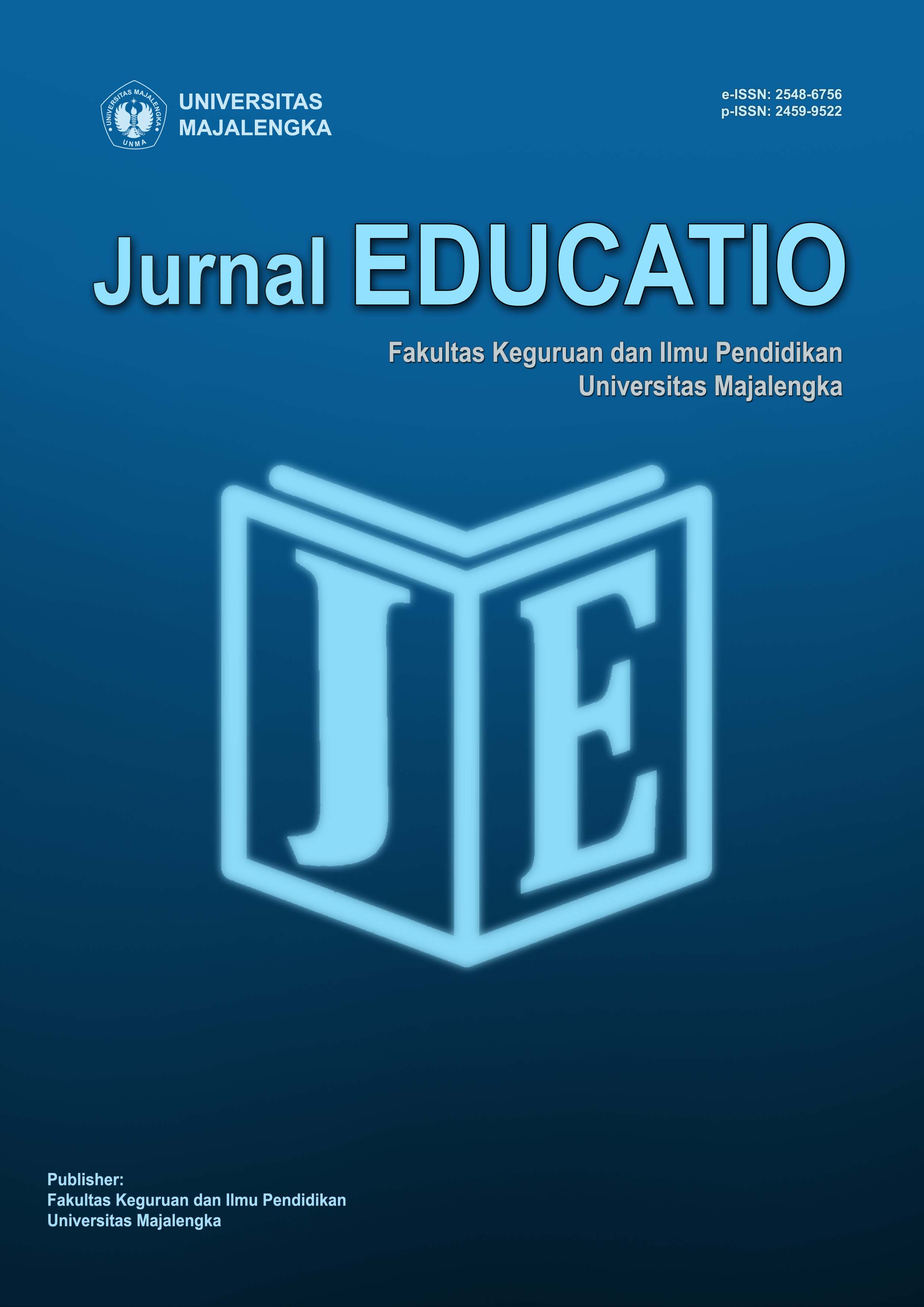The Walisongo's Abangan and Putihan Da'wah Methods in the Land of Java
Comparative Study of the Da'wah Methods of Sunan Kalijaga and Sunan Giri
DOI:
https://doi.org/10.31949/educatio.v11i1.11968Abstract
The beginning of the spread of Islam in the archipelago began in the 11th century in the Malacca Peninsula area spread by merchants from the Middle East. While Islam began to settle in Java in the 14th century along with the collapse of the Majapahit Kingdom. The method used in this research is the Qualitative method, using a descriptive approach. The data collection method used by researchers is the interview method and Library Research. The specific research is on the dualism of the Walisongo da'wah flow, especially on the Abangan method used by Sunan Kalijaga and the Putihan method used by Sunan Giri. The method of da'wah used by Sunan Kalijaga and Sunan Giri was because the Javanese people had embraced the belief before Islam set foot in Java, this belief was called Kejawen or Kapitayan. The process of spreading Islam took place peacefully without any violence. The result of this dualism is the division of Muslims in Java, known as Abangan Islam and Putihan Islam. The Abangan Islam tends to worship using art, for example by using Javanese gending or songs, while the Putihan Islam worship based on the Qur'an and Hadith kaffah (perfect), they consider worshiping using art is a shirk.
Keywords:
Walisongo da’wah, putihan school, abangan school, sunan kalijaga, sunan giriDownloads
References
Afandi, A. A. (2024). Pribumisation of Islam: The Role of Walisongo and the Development of Islam in Java. Javano-Islamicus1(2), 90–104.
Alaslan, A. (2017). Qualitative Research Methods (Vol. 4, Issue 1).
Alif, N., Mafthukhatul, L., & Ahmala, M. (2020). Acculturation of Javanese Culture and Islam Through the Da'wah of Sunan Kalijaga. Al'adalah,23 (2), 143-162. https://doi.org/10.35719/aladalah.v23i2.32
Borrego, A. (2021). No主観的健康感を中心とした在宅高齢者における 健康関連指標に関する共分散構造分析Title. 10(12), 6.
Dicky Darmawan, M. M. (2022). The Role of Walisongo in the Spread of Islam in Java. Kompas.Com,6 (02), 11-20. https://www.kompas.com/skola/read/2020/02/15/110000569/peran-walisongo-dalam-penyebaran-islam-di-tanah-jawa?page=all
Fery, M., Islam, U., Hasan, Z., & Probolinggo, G. (2023). The Concept and Character of Waliyullah in Surah Yunus Verse 62. Tafhim Al-'Ilmi : Journal of Education and Islamic Thought, 14(2), 279–291.
Friyadi, A. (2022). The Path to Becoming Waliyullah in the Hadith of Arbain Nawawi Hadith 38. JASNA: Journal For Aswaja Studies,2 (2), 41-54. https://doi.org/10.34001/jasna.v2i2.3713
Hamiyatun, N. (2019). The Role of Sunan Ampel in Islamic Da'wah and the Formation of Nusantara Muslim Society in Ampeldenta. Dakwatuna: Journal of Islamic Da'wah and Communication,5 (1), 38. https://doi.org/10.36835/dakwatuna.v5i1.321
Hasan, M., Islam, P., & Dakwah, F. (n.d.). HIS DA'WAH METHOD. 23010260046.
Husna, N. (2021). Islamic Da'wah Methods in Qur'anic Perspective. Journal of Selasar KPI: Communication and Da'wah Media Reference,1 (1), 97-105. https://www.ejournal.iainu-kebumen.ac.id/index.php/selasar/article/view/319
Ibdalsyah, Ramly, A. T., & Rosyadi, R. (2023). Strategic Management of Walisongo's Da'wah in Java Island Region. Journal of Management,14 (2), 290-304. https://doi.org/10.32832/jm-uika.v14i2.715
Ismail, Mindani, Siti Hodijah, A., Agus Ainur Rasyid, M., & Yonani, S. (2024). Approaches, Strategies and Methods of Da'wah of Walisongo in the Process of Islamisation of Java. INNOVATIVE: Journal of Social Science Research, 4(1), 13140–13148.
Kaltsum, L. U., Dasrizal, & Tsauri, M. N. (2022). Animism and Dynamism Beliefs in Muslim Communities of East Nusa Tenggara. Journal of Society and Culture,24 (1), 15-34. https://doi.org/10.55981/jmb.1281
Lisma, N. (2023). The Development of Islam in the Archipelago. Journal of Actualisation of Islamic Education, 18(1), 45–56.
Ningsih, R. (2021). THE COMING AND DEVELOPMENT OF ISLAM Introduction The coming of Islam to Indonesia. Scientific Forum, 18(2), 212–227.
Nurul Syalafiyah, & Budi Harianto. (2020). Walisongo: Islamic Da'wah Strategy in the Archipelago. J-KIs: Journal of Islamic Communication,1 (2), 41-52. https://doi.org/10.53429/j-kis.v1i2.184
Purhasanah, S., Rohmatulloh, R., & Al Ayyubi, I. I. (2023). The Role of Wali Songo in Spreading Islam in Indonesia. Jazirah: Journal of Civilisation and Culture,3 (1), 206-213. https://doi.org/10.51190/jazirah.v3i1.66
Rachmawati, D. K., & Pramudya, D. A. (2022). Ideological Hegemony in the Lyrics of Tembang Dolanan Sunan in Indonesia. Nusa: Journal of Language and Literature,17 (3), 221-235. https://doi.org/10.14710/nusa.17.3.221-235
S.Ag., ME, H. (2017). Walisongo's Da'wah Strategy and Method. Al-Hiwar: Journal of Da'wah Science and Engineering,3 (5). https://doi.org/10.18592/al-hiwar.v3i5.1193
Setyaningsih, R. (2020). Javanese Cultural Acculturation as a Da'wah Strategy. Ri'ayah: Journal of Social and Religious Affairs,5 (01), 73. https://doi.org/10.32332/riayah.v5i01.2304
Sugiyono. (2019). Understanding the Differences between Qualitative Analysis and Quantitative Analysis in Scientific Research. Management, 13–20.
Sunyoto, A. (n.d.). Anyakrawati in relation to the meaning of a person who has competence and authority in terms of teaching. 254–308.
Ulya, I. (2022). Islamisation of the Archipelago: The historicity of early Islam (VII - XV century AD) and the role of Wali Songo in Nusantara. Historiography,2 (3), 442. https://doi.org/10.17977/um081v2i32022p442-452
Warsini, W. (2022). The Role of Wali Songo (Sunan Bonang) with Da'wah Media in the History of the Spread of Islam in Tuban, East Java. ASANKA: Journal of Social Science And Education,3 (1), 23-45. https://doi.org/10.21154/asanka.v3i1.3832
Published
How to Cite
Issue
Section
License
Copyright (c) 2025 M. Syaifuddin Alfaruq, Abdul Rozaq

This work is licensed under a Creative Commons Attribution-ShareAlike 4.0 International License.
An author who publishes in the Jurnal Educatio FKIP UNMA agrees to the following terms:
- Author retains the copyright and grants the journal the right of first publication of the work simultaneously licensed under the Creative Commons Attribution-ShareAlike 4.0 License that allows others to share the work with an acknowledgment of the work's authorship and initial publication in this journal
- The author is able to enter into separate, additional contractual arrangements for the non-exclusive distribution of the journal's published version of the work (e.g., post it to an institutional repository or publish it in a book) with the acknowledgment of its initial publication in this journal.
- The author is permitted and encouraged to post his/her work online (e.g., in institutional repositories or on their website) prior to and during the submission process, as it can lead to productive exchanges, as well as earlier and greater citation of the published work













